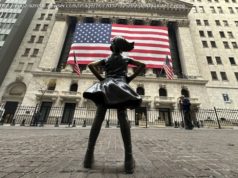Stocks were higher Wednesday after data showing January consumer price inflation stronger than expected.
U. S. stocks turned higher and were back in positive territory for the year as traders shrugged off the latest sign that inflation is firming after a report showed consumer prices in January rose faster than expected.
While the consumer price index, or CPI, isn’t normally a must-see number on Wall Street after years of tame inflation, it is once again on traders‘ radar after a report earlier this month showed hourly wage inflation at its highest level since 2009. That sparked fears that inflation — and interest rates — are on the move higher, a trend shift that sparked the recent market turbulence.
Fears of rising inflation was reinforced Wednesday when CPI rose at a faster-than-expected 2.1% annual pace, above the 1.9% Wall Street had forecast.
Rising inflation expectations initially pushed stock prices lower, as investors see it as resulting in higher interest rates. But the market rebounded as investors started to come around to the idea that while inflation is rising, it is not skyrocketing.
In afternoon trading, the Dow Jones industrial average, which is on track for its fourth straight session of gains after a massive selloff last week briefly pulled it down more than 10% from its peak, was up 185 points, or 0.8%. The Dow had been down 150 points.
The morning selloff was „an overreaction to the fear of rising inflation,“ says Jeff Carbone, managing partner at Cornerstone Wealth. „A 2% CPI is not a hyper inflation number.“
Stronger inflation readings will likely cause interest rates to move higher. And that was the case Wednesday when the yield on the 10-year Treasury note rose as high as 2.91%, a fresh four-year high.
„Today’s CPI confirms that inflation is trending higher,“ says Charlie Ripley, senior investment strategist at Allianz Investment Management in Minneapolis. „The big picture story is that inflation, which pretty much flat-lined for a while, is moving back up.“
The key level to watch is 3% on the 10-year U. S. government bond, as that is a key area that could create added pressure on stocks, adds Ripley. The last time the 10-year closed above 3.0% was Jan. 9,2014.
„Psychologically, 3% is a big number,“ says Ripley, adding that if inflationary pressures continue to build the Federal Reserve may have to hike short-term interest rates this year more than the three times they have signaled to cool off an overheated economy. Higher borrowing costs slow economic growth.
The stock market’s rise Wednesday coincided with a big drop in Wall Street’s „fear gauge,“ known as the VIX. The VIX, a gauge of future market volatility in the next 30 days, fell by more than 20% Wednesday to a level below 20. That’s nearly half of where it was on Feb. 5 when it more than doubled in a single day and closed at 37.32, a record spike that exacerbated turbulence in the stock market.
The market’s muted reaction to today’s stronger-than-expected CPI could be due to the fact that the spike wasn’t massive, and also came on a day when January retail sales came in weaker than expected, said Mike Loewengart, VP of investment strategy at E-Trade.
Both factors, he suggests, means the Fed may not need to get overly aggressive with rate hikes.
„Cooler heads will tell you the potential for an accelerated rate hike agenda from the Fed still looks unlikely,“ says Loewengart.
For now, stock investors are focusing on market positives, such as a strong U. S. economy, a solid labor market and growth in most economies around the world, says Ripley.
For now, „the rising inflation expectations shouldn’t be considered something to panic about,“ Ripley adds.
The next key inflation data point to watch is the producer price index, or PPI, set for release Thursday. The PPI measures wholesale price pressures in the economy.






